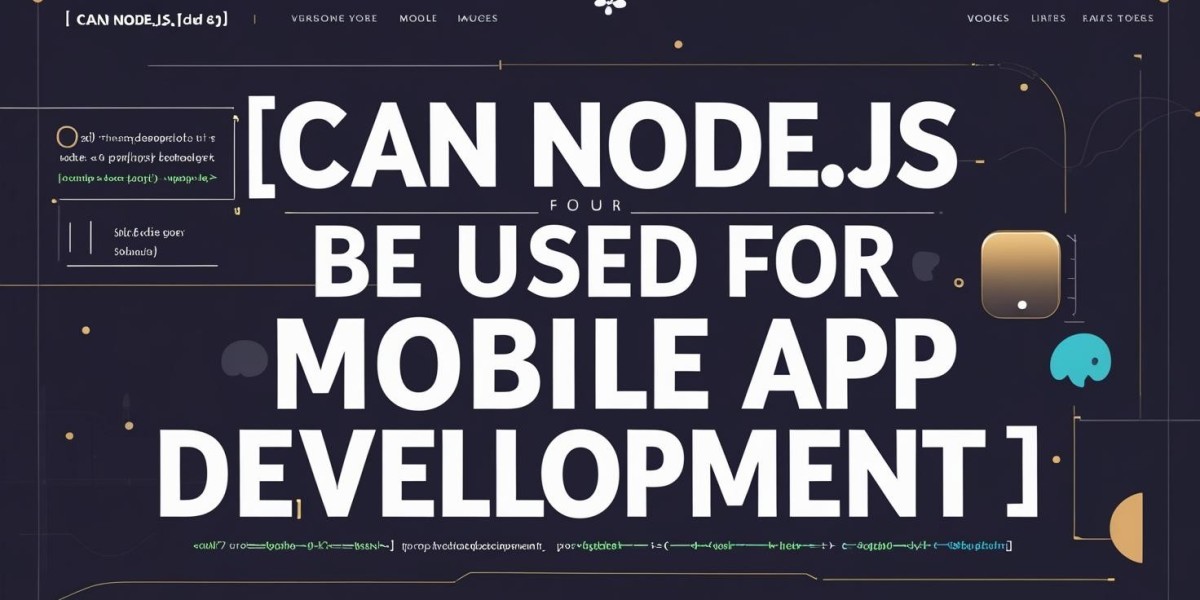Is it possible to make mobile apps with Node.js in 2025? Think about this: The mobile app market is expected to grow to more than $550 billion by 2027. This huge growth makes the question that development teams are always asking louder!!! How do we build mobile apps taht are strong, scalable, and fast? Node.js is a common technology that comes up a lot in this conversation. Is Node.js a good choice for making mobile apps, especially as we get closer to 2025? The short answer is a clear yes, but maybe not in the way most people think at first.
The Changing Landscape of Mobile Development in 2025
The mobile world in 2025 is more complicated and changing than ever before. Developers need to find powerful, efficient tools because users expect experiences to be instant and seamless. Node.js is an interesting option because it has a non-blocking I/O model and the V8 JavaScript engine. Because it can handle a lot of connections at once, it is a great choice for the demanding backend infrastructure that modern mobile apps need. There have been big changes in the way mobile apps work. It used to be that native-only development was the only thing that mattered. Cross-platform solutions and hybrid frameworks have become very popular. They make it easier for everyone to make things and reach more people. Node.js doesn't directly make user interfaces for iOS or Android. That's a common mistake. Its strength is in its ability to handle data, logic, and server-side operations, which is like the brain of your application. When I have led development teams, I have seen that the best way to get the most out of Node.js is to pair it with the right mobile framework.
Node.js is a powerful backend for mobile apps.
There is no doubt that Node.js works well as a backend technology for mobile apps. To give users the responsive mobile experiences they expect, it needs to be fast, work in real time, and be able to grow. Any modern app, like social media feeds, ride-sharing services, or instant messaging, needs to be able to quickly get data and often get updates in real time. Node.js is great for this, which is why it's the best choice for the API layer that powers your mobile app.
Node.js for Microservices and Real-Time Communication
Because of its event-driven architecture, Node.js is the best choice for apps that need to work in real time. Push notifications, chat features, and live data feeds are all things that can be done in an app. Socket.IO and other libraries use Node.js to make low-latency, two-way communication channels between your server and mobile clients. Also, microservices architecture is a great fit for Node.js. . Because it is lightweight, it is possible to break up complex applications into smaller, separate services, each of which handles a different feature. This modularity not only makes it easier to maintain, but it also makes it possible to scale components independently, which is important for dealing with changing mobile traffic. In my opinion, this modularity makes debugging a lot easier than it is with monolithic backends.
Handling Data and Making APIs Strong
Data exchange is a big part of any mobile app. Node.js is a strong platform for making RESTful APIs or GraphQL endpoints. It is often used with well-known frameworks like Express.js or NestJS. These APIs connect your mobile front-end to your databases, making sure that data is fetched and changed quickly. Node.js does I/O operations in an asynchronous way, which means it can handle many database queries and network requests at the same time without stopping the main thread. This built-in design helps avoid performance problems that can happen in synchronous environments, making the experience smoother for your mobile app users. For example, a Node.js backend would quickly handle a lot of product requests, user authentications, and order placements at the same time in a large-scale e-commerce mobile app, making sure that users don't have to wait long.
Can Node.js power your mobile front end? Taking Apart Cross-Platform
Node.js isn't directly used to render UI on mobile devices, but it is the most important building block for many cross-platform frameworks that use JavaScript. These frameworks use Node.js for things like building, managing packages, and sometimes even their development servers. It's not so much that Node.js is the mobile front-end as that it lets you make mobile front-ends with JavaScript skills you already have.
React Native: The Best Way to Go
When you talk about Node.js in relation to mobile front-ends, React Native always comes up. Facebook made React Native, which lets developers use JavaScript and React ideas to make real native mobile apps for iOS and Android. Node.js is the runtime environment for React Native's tools, such as the React Native CLI, Metro bundler, and NPM (Node Package Manager). In short, Node.js is needed for your React Native development environment to work. Your frontend team, who probably knows JavaScript well, can easily switch to mobile cross-platform development. They can share codebases and knowledge between web and mobile, which speeds up the development process by a lot. This is especially interesting to businesses that want to get the most out of their teams.
Ionic and Cordova: A Mixed Option
Using frameworks like Ionic or Apache Cordova (PhoneGap) is another option. These frameworks for mobile app development in new york let developers make mobile apps using standard web technologies like HTML, CSS, and JavaScript. After that, they put this web app inside a native shell using a WebView component. Node.js is also very important here because it is the build tool and package manager, just like it is in React Native. These can speed up development and make it easier to move apps from the web to mobile, but the performance may not always be as good as that of a fully native app or even a React Native app, especially for user interfaces that are graphically complex or heavy. But for content-driven or business apps, they are a perfectly good and cheap way to go.
Steps and Methods for Making Mobile Apps with Node.js
To build a mobile app with Node.js as a main part, you need to follow a plan. It's not just one tool that makes the whole app; it's a combination of tools that work well together. These are the steps and methods we support:
A plan for synergy in architecture
Make a full architectural plan before you start writing any code. Choose between a single RESTful API service and a set of microservices. Pick a database, either NoSQL (like MongoDB) or SQL (like PostgreSQL), based on how your data is structured and how much it needs to grow. From the start, plan for authentication (JWT is a common choice), authorization, and how to handle errors. A well-planned blueprint keeps you from having to do a lot of work later.
How to Set Up Your Development Environment
Installing Node.js: Make sure your computer has Node.js and npm (Node Package Manager). These are the basic tools for managing packages and writing JavaScript on the server side. Use Git for version control. Code Editor: Choose a strong code editor like VS Code, which is highly recommended because it has great JavaScript support and extensions. Setting Up the Database: Set up the database you want to use, either on your own computer or through a cloud service. Mobile SDKs: To make a React Native app, you need to install Xcode for iOS and Android Studio for Android.
Making the Backend API with Node.js
Choosing a Framework: The first step is to pick a strong Node.js framework. Express.js is a tried-and-true, strong way to make REST APIs. NestJS has a more opinionated, modular structure, similar to Angular, that works well for big projects. Route Definition: Set up the API routes that your mobile app will use, such as /users, /products, and /orders. Data Models: Make schemas for NoSQL databases like MongoDB with Mongoose or ORM models for SQL databases like Sequelize that show how your app's data is structured. Business Logic: Your API endpoints should handle requests, talk to the database, and send responses, which is the main business logic. Authentication and Authorization: Add a safe way to verify identity. Passport.js is a flexible middleware for Express.js that works with a number of different strategies. Make sure that all endpoints are safe as needed.
Combining Node.js Backend with Mobile Front-End
Client-Side Request Library: In your React Native (or Ionic/Cordova) mobile app, use a library like Axios or the built-in Fetch API to send HTTP requests to your Node.js backend API. Data Flow: Set up your front-end components so that they can send and receive data from your back-end. Handle different API responses, such as getting data successfully, getting an error, or getting a validation message. Real-Time Integration: To add real-time features, use a library like Socket.IO on both the Node.js backend and your mobile front-end. This will create permanent, two-way communication channels.
Strict Testing and Deployment Plans
After development, testing is very important. Use tools like Postman or Insomnia to check your API endpoints. Do unit, integration, and UI tests for the mobile app. Performance testing is very important because it lets you see how your Node.js backend responds when there are a lot of users at once. Finally, Node.js for mobile apps needs a strong deployment. You can use cloud platforms like AWS EC2, Google Cloud Run, or Heroku, or you can use serverless functions like AWS Lambda. A continuous integration/continuous deployment (CI/CD) pipeline automates testing and deployment, which makes the release process faster.
Common Mistakes and Expert Advice
Node.js has many benefits for making mobile apps, but there are also some problems that need to be fixed. One common mistake is not taking full advantage of Node.js's asynchronous nature, which can cause "callback hell" or synchronous operations that slow things down.
Avoiding Problems with Scalability
Node.js is naturally scalable, but if you set it up wrong, it won't work. You should stay away from heavy CPU-bound tasks in the main event loop because they will stop other tasks from happening. Think about giving these kinds of tasks to other processes or microservices. With load balancers and clustering using the "cluster" module, which creates multiple Node.js processes and spreads the work across CPU cores, Node.js for mobile apps can handle a lot of traffic. My professional opinion is that you should invest early in strong logging and monitoring so you can find and fix performance problems before they get worse.
Making mobile security stronger
Security is an important thing to think about. Use strong input validation to stop injection attacks. Use HTTPS for all communication between the mobile app and the Node.js backend. It is very important to handle authentication tokens (like JWT) and environment variables correctly. To fix known security holes, you should update Node.js and its dependencies on a regular basis. From what I've seen, security breaches are more likely to happen because of simple mistakes than because of very advanced attacks.
Ecosystem and Tool Skills
There are a lot of tools and libraries in the Node.js ecosystem that make it easier to make mobile apps.
Backend Frameworks: Express.js (simple and flexible), NestJS (opinionated, TypeScript-first, enterprise-grade), and Fastify (focused on performance).
Mongoose (MongoDB ODM), Sequelize (SQL ORM), and TypeORM (ORM for different databases) are all good for managing databases.
Socket.IO for real-time communication.
Passport.js is used for authentication.
Postman and Insomnia are two tools for testing APIs.
Deployment: Heroku, DigitalOcean, Docker, Kubernetes, AWS Lambda (for serverless).
| Aspect | Tool/Framework(s) | What it is |
|---|---|---|
| Web Frameworks | Express.js, NestJS, Fastify | Frameworks for building RESTful APIs or GraphQL endpoints |
| Database ORM/ODM | Mongoose, Sequelize, TypeORM | Libraries for interacting with NoSQL (MongoDB) or SQL (PostgreSQL) |
| Real-Time Features | Socket.IO | Library for bi-directional real-time communication |
| Authentication | Passport.js, JSON Web Tokens | Libraries/strategies for verifying users and granting access |
| Testing | Jest, Mocha, Chai, Supertest | Frameworks and libraries for unit, API, and integration testing |
| Deployment | Docker, AWS Lambda, Heroku | Tools and platforms for packaging, deploying, and managing applications |
Main Points
Node.js is a great backend solution for mobile apps because it has non-blocking I/O, is fast, and can work in real time.
It doesn't directly build mobile user interfaces. Instead, it gives power to cross-platform development frameworks like React Native and hybrid solutions like Ionic/Cordova.
A well-organized backend architecture that uses Node.js makes sure that mobile app development is scalable and strong.
For successful deployments, it is very important to pay attention to security, performance optimization, and thorough testing.
The Node.js ecosystem has a full set of tools for every step of the development process.
Questions that are often asked
- What framework works best for modern mobile app backends? Node.js has frameworks like Express.js and NestJS that are the best options.
- Can Node.js make it easier to build mobile front-end logic right away? Node.js is mostly used for server-side tasks, not for rendering mobile user interfaces directly.
- Does Node.js work well with real-time features? Yes, its event-driven nature and tools like Socket.IO make it possible to have powerful real-time features.
- How does Node.js handle the needs of large-scale applications so well? It can handle a lot of users because it processes things asynchronously and can scale horizontally.
- What tools are available for developers to use when making mobile apps? Node.js has a lot of documentation, a lot of people using it, and a lot of strong libraries.
Suggestions
If you're a business or developer in 2025 and you're wondering, "Can Node.js be used to make mobile apps?" I strongly suggest that you use its features. If you use Node.js wisely for your backend, you can create APIs that can scale and perform well enough to power a wide range of mobile front-ends, whether they are native (using React Native) or hybrid (using Ionic). This practical approach makes use of the JavaScript skills that many teams already have, which speeds up time to market and makes things more efficient. Node.js is dynamic, so your app can grow and change as the mobile market grows and changes. Start making your Nodeo.js mobile app today! You can use this powerful technology by working with expert developers or by teaching your team more about it. Node.js is everywhere, and it could be the engine behind your next successful mobile app.













